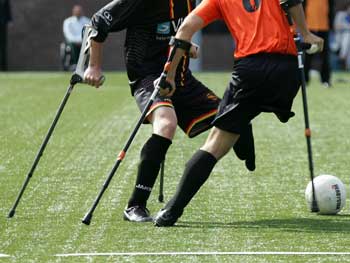Amputation Lawyer in Baltimore: Helping You Seek Justice and Compensation
 An amputation injury can be a life-altering event, both physically and emotionally. Losing a limb can affect your ability to work, engage in daily activities, and enjoy life as you did before the injury. If you or someone you know has suffered an amputation injury due to someone else’s negligence, you may be entitled to compensation for your losses.
An amputation injury can be a life-altering event, both physically and emotionally. Losing a limb can affect your ability to work, engage in daily activities, and enjoy life as you did before the injury. If you or someone you know has suffered an amputation injury due to someone else’s negligence, you may be entitled to compensation for your losses.
At Law Offices of Steven H. Heisler, we understand the challenges that amputees face, and we are committed to helping them recover the compensation they deserve. Our experienced Baltimore amputation injury lawyers have the knowledge and resources to handle even the most complex cases. If you need help pursuing your rights after a loss of limb injury, we are here to help.
Amputation Injuries: Understanding the Statistics
Amputation injuries are unfortunately common in the United States. According to the National Limb Loss Information Center, approximately 2 million people in the U.S. are living with limb loss, and this number is expected to double by 2050.
Here are some other statistics that shed light on the prevalence and impact of amputation injuries:
- Traumatic amputations account for 45% of all limb loss cases, while vascular disease, including diabetes, accounts for 54% of cases.
- The most common causes of traumatic amputations are motor vehicle accidents, work-related injuries, and accidents involving machinery and tools.
- Men are more likely than women to suffer an amputation injury, with a ratio of approximately 4 to 1.
- The average hospital stay for an amputation injury is 11 days, with an average cost of $55,000 per stay.
- The average lifetime cost of an amputation injury can range from $500,000 to $1 million or more, depending on the severity of the injury and the individual’s medical needs and living situation.
- Amputation injuries can lead to significant physical and emotional challenges, including phantom limb pain, depression, anxiety, and difficulty adjusting to a new way of life.
These statistics highlight the seriousness of amputation injuries and the need for experienced legal representation to help victims recover the compensation they deserve. At the Law Offices of Steven H. Heisler, we are committed to fighting for the rights of amputation injury victims and helping them rebuild their lives.
Steps to Take After an Amputation Injury
If you or someone you know has suffered an amputation injury, it’s essential to take the following steps to protect your health and legal rights:
- Seek Medical Attention: An amputation injury requires immediate medical attention to prevent further damage and increase the chances of successful reattachment or prosthesis.
- Document the Incident: If possible, take photos of the accident scene and your injuries. Write down the names and contact information of any witnesses and the details of the incident.
- Notify the Responsible Party: If your amputation injury was caused by someone else’s negligence, notify them of the incident and keep a record of your communication.
- Consult with an Experienced Amputation Injury Lawyer: A knowledgeable and experienced amputation injury lawyer can help you understand your legal options and pursue the compensation you deserve.
- Follow Your Doctor’s Orders: It’s essential to follow your doctor’s orders and attend all medical appointments to ensure you receive the best possible care and document your injury’s extent.
Who We Are
Law Offices of Steven H. Heisler is a leading personal injury law firm in Baltimore, Maryland, serving clients for over 30 years. Our founder, Steven H. Heisler, is a dedicated and experienced attorney who has recovered millions of dollars for his clients. He is committed to helping injured individuals and their families get the justice and compensation they deserve.
We handle a wide range of personal injury cases, including amputation injuries caused by:
- Car accidents
- Motorcycle accidents
- Truck accidents
- Medical malpractice
- Workplace accidents
- Defective products
- Slip and fall accidents
- Medical Malpractice.
We understand the complex legal and medical issues involved in amputation injury cases and work closely with our clients to ensure they receive the best possible outcome.
Why Choose Us
At the Law Offices of Steven H. Heisler, we are committed to providing our clients with personalized attention, aggressive representation, and exceptional results. Here are some reasons why you should choose us to handle your amputation injury case:
- Experience: Our Baltimore amputation injury lawyers have decades of experience handling personal injury cases, including amputation injuries.
- Resources: We have the resources and expertise to investigate your case, gather evidence, and build a strong case on your behalf.
- Compassion: We understand the emotional and physical toll that an amputation injury can have on you and your family. We treat our clients with compassion and respect throughout the legal process.
- Communication: We keep our clients informed about their cases and respond promptly to their questions and concerns.
- Results: We have a track record of success in recovering millions of dollars in compensation for our clients.
If you or a loved one has suffered an amputation injury due to someone else’s negligence, don’t hesitate to contact our Baltimore amputation injury lawyers at Law Offices of Steven H. Heisler. We offer a free consultation to discuss your case and answer any questions you may have. We work on a contingency fee basis, which means you don’t pay us unless we recover compensation for you.
Contact Us Today
In conclusion, suffering an amputation injury can be a traumatic and life-changing experience. If you or someone you know has suffered a loss of limb injury due to someone else’s negligence, don’t hesitate to contact the Baltimore amputation injury lawyers at Law Offices of Steven H. Heisler at (410) 625-4878. We are committed to helping our clients seek justice and compensation for their losses.
FAQs about Amputation Injury Cases
If you or a loved one has suffered an amputation injury, it’s important to have as much information as possible about your legal options.
What is an amputation injury?
An amputation injury is the loss of a limb or part of a limb due to an accident, injury, or medical condition. It can be a traumatic event that requires immediate medical attention.
How can an amputation injury affect my life?
Losing a limb can affect your ability to work, engage in daily activities, and enjoy life as you did before the injury. It can lead to physical and emotional challenges, including depression, anxiety, and post-traumatic stress disorder (PTSD).
How long do I have to file an amputation injury claim?
The statute of limitations for filing an amputation injury claim varies depending on the state and the type of case. In Maryland, the statute of limitations to file a claim is three years from the date of the injury. It’s best to consult with an experienced amputation injury lawyer as soon as possible to ensure your rights are protected.
How much compensation can I receive for my amputation injury?
The amount of compensation you may receive for your amputation injury depends on various factors, such as the severity of your injury, the impact on your life, and the liability of the responsible party. An experienced amputation injury lawyer can help you determine the value of your case.
At Law Offices of Steven H. Heisler, we understand the physical, emotional, and financial challenges that come with amputation injuries.

Attorney Steve Heisler
Steve Heisler decided in 1996 that he was going to focus his law practice exclusively on injury cases. Since then, he has been representing injured people against insurance companies, disreputable medical practitioners and Big Pharma, and doing it with compassion, honesty and level-headed rationality. [ Attorney Bio ]

